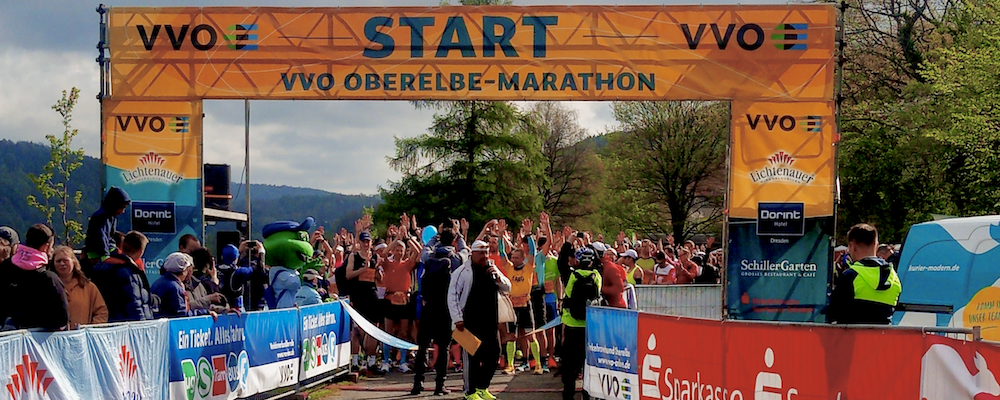Overall rating: 8/10 see why at the end of the report | comparison of all my races
Marathon season 2023 was going to start with a race that has been on my mind for a while now: Oberelbe-Marathon. A point-to-point course along the Elbe River in East-Germany, from Königstein close to the Czech border all the way to Dresden, the federal state of Saxony’s capital. The event promised a flat course, beautiful sights and views, and an overall unforgettable experience. They did not disappoint!
Mountains and castles
Point-to-point races have that one disadvantage that you somehow have to either get to the starting line in the morning or back to it after the race. Today’s situation was the former, and a one our drive was be done before the start. I was visiting Germany for some vacation days and stayed at my dad’s house in the village of Lichtenwalde. He kindly offered a ride, being interested in the spectacle himself, but as an observer rather than a participant. This is the very Eastern part of Germany, part of the Erzgebirge mountain area. The drive even further east along mostly calm and windy country roads was getting more and more picturesque the closer we got to Königstein, a tiny town populated with just over 2000 residents, right at the Elbe River and located below a famous 400 year old fortress that rises more than 200 meters above the river itself. This part of the Erzgebirge is called national park Sächsische Schweiz (“Saxon Switzerland”) and known for its unique sandstone formations characterizing the landscape. I’ve spent many of my teenager days in this area; hiking, bouldering, and climbing. But never had I run here before and was excited to be back after more than two decades.
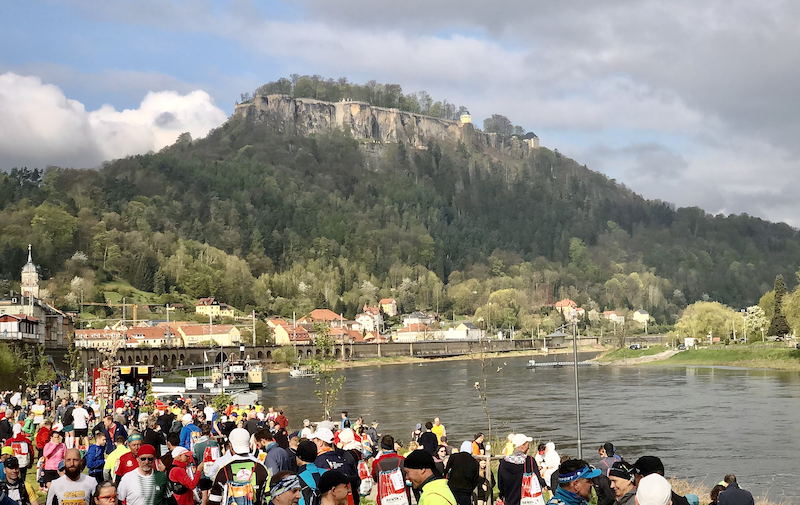
The spectator boat
The Oberelbemarathon has been around for almost a quarter of a century and takes place annually in April. Its course follows the Elbe River bike path from Königstein all the way to Dresden and is almost entirely car-free. About 600 runners registered for the full distance of 42.2 kilometers and gathered around the starting area. It was just after 8:45am when my dad and I arrived and there was enough time left to soak in the atmosphere, taking some pictures of the surroundings before getting ready for the run.

This event uniquely features a ferry boat, which follows the runners along the river all the way to the finish, and lets spectators experience the marathon from a different perspective than most likely any other marathon race. Twenty minutes before the start people began boarding the boat, while participants were seeding themselves into their starting corrals. I wasn’t really sure what I should go for, there wasn’t a specific goal I had in mind and basically just decided shortly before the start that I’d try to go for a finish time of under 3h20m for this year’s first marathon, which would mean a pace of around 4:40 minutes per kilometer.
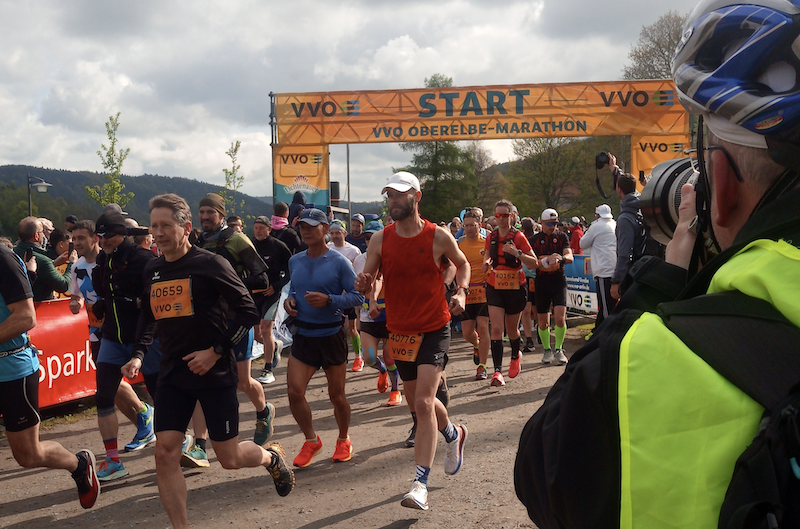
10km of nature running
At 9:20am the race started under blue skies and an air temperature of comfortable 14ºC. I settled into my pace quickly, knowing that 4:40 was a sustainable tempo for me. The path was somewhat narrow for the relatively big field of runners and the first couple of minutes were a bit stressful, as often in these events, but it did not take too long until everyone was spread out far enough for each runner to have their own space. The first ten kilometers were truly enjoyable. This was nature running at its finest. Along small herds of sheep and flocks of chicken and through very little, cozy villages, where the few local spectators didn’t seem to be sure whether they should be cautiously cheering or rather sceptically watching that unfamiliar crowd of runners, all dressed in colorful technical gear; a sight that most likely only on that particular day could be observed. Such a different mentality from folks in North America!
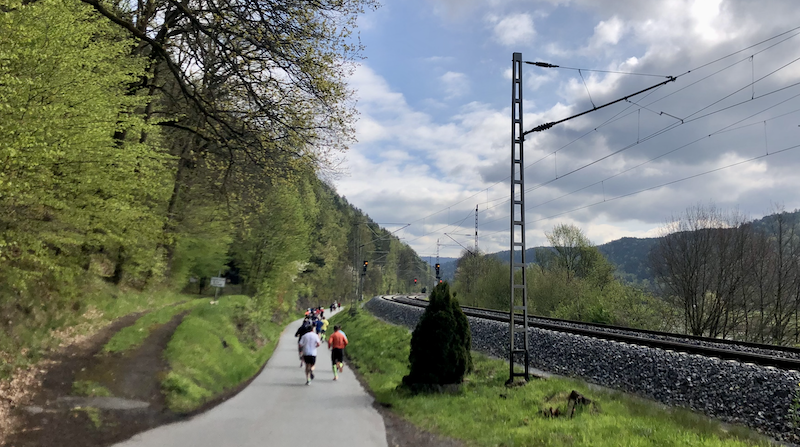
The course turned out to be a bit rolling in the beginning. Even following along the river, we were clearly in the middle of a mountain area that forced the path over a couple ups and downs. Most of it was asphalt, with some occasional stretches of gravel; easy enough to run on. We were running left of the river, and the views on the right side were spectacular. The Elbsandsteingebirge (this part of the sandstone mountains within the Saxon Switzerland area) has amazing views to offer; one of which was the Bastei, a rock formation rising almost 200m above the Elbe River just around the 7km mark. Still early in the run my legs felt fresh and my mind was just blown by the visual stimuli all around me.
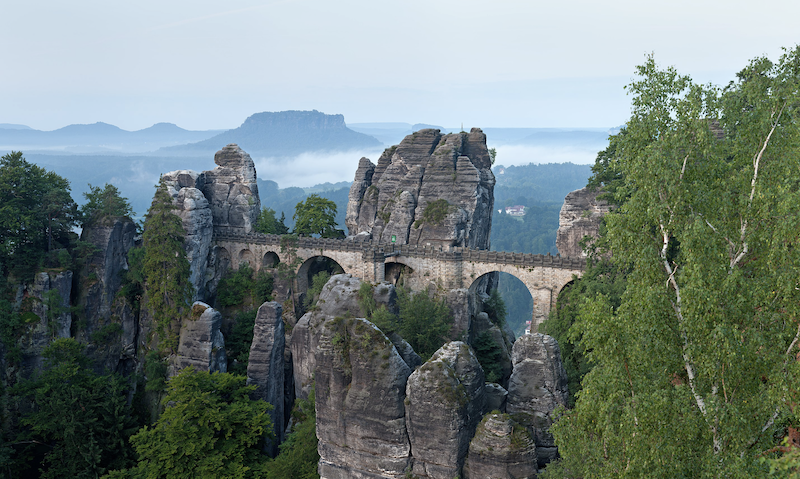
A short loop through Pirna
It wasn’t until the halfway point that the profile of the course changed up a bit. The area got a bit flatter, and wider overall, when we were about to enter the midsized town of Pirna where the course would do a little detour away from the Elbe River cycling path, right into the city center. The runners would be greeted by musical acts, local spectators in clearly better moods than the ones described earlier, and by some good uphill running on cobblestones. The change of scene was quite welcome, knowing that it would become remote again for quite a bit before entering the Saxon capital of Dresden.
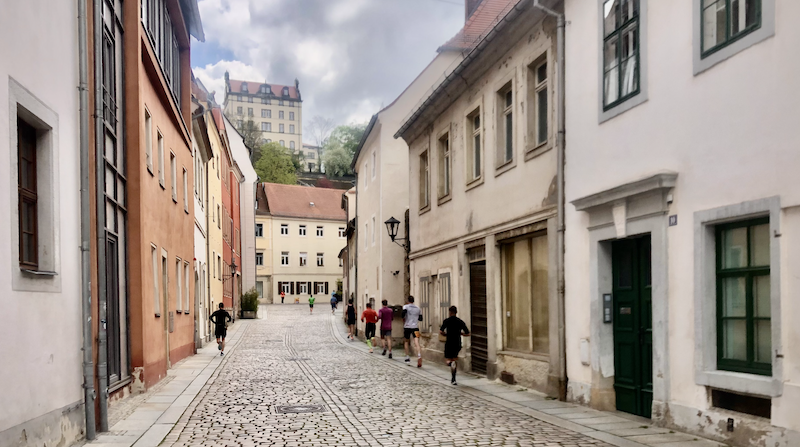
My pace was still very constant at just below 4:40min/km and my watch showed 1h39m when I crossed the half marathon mark. Given that I didn’t feel any discomfort yet and a heart rate in the low 160s I felt confident about the next 21 kilometers. Compared to previous marathons and given the overall very flat course my choice of pace was relatively conservative, and I wasn’t going for a personal best at this first race of the year. It feels great knowing that you can run for hours and enjoy literally all of it!
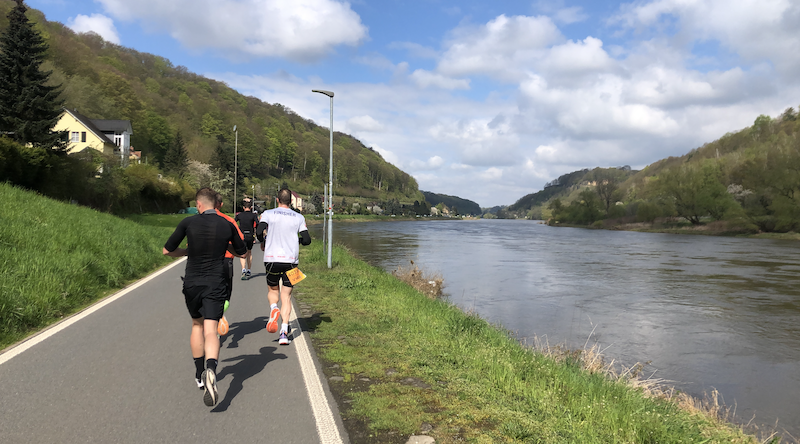
Entering Dresden
Unlike many other races I never came across a major challenge during this run, not even past the 30km mark. My pace even picked up a bit when I entered the outer parts of Dresden which all were very familiar to me. I lived in this city for a while just after I finished studying in 2010. Back then I did not run at all, but explored my surroundings by bike and this cyclepath was very much familiar to me.
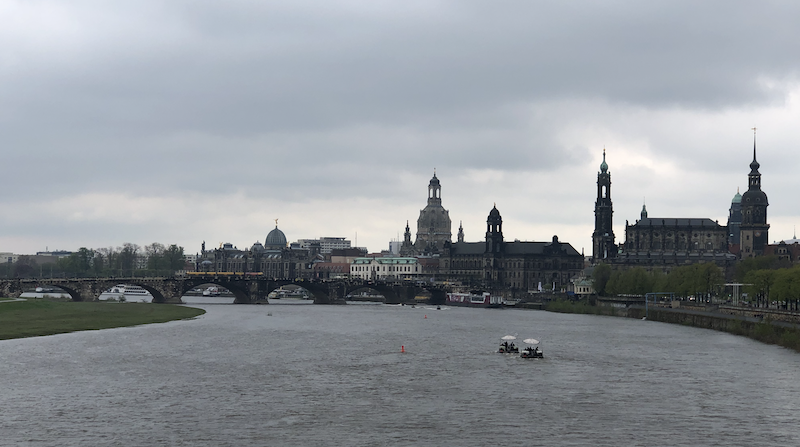
I already passed the Pillnitz castle on the other side of the river at kilometer 28 and was now close to the big bridge Blaues Wunder (“blue miracle”) which in my mind marked the final stretch into downtown. The last five kilometers were getting better and better. Spectators cheered loudly, music stations became more frequent, and seeing the city’s historic skyline dominated by the Frauenkirche (“Church of our Lady”) and impressive bridges kept made what usually is the hardest part of the race still enjoyable.
When the finish line was in sight, I almost couldn’t believe that I was just about to end a marathon run without experiencing any serious physical nor mental challenges with a respectable time of 3 hours and 18 minutes. My third-best result after Ottawa and Hamilton Marathons last year, but without all the struggling. It also must have been my most consistent race altogether, having managed to run a negative split of one second.The finish area was set up in an outdoor athletics stadium, providing enough space for runners and spectators to celebrate their accomplishments while refueling their bodies. Two friends from high school had run the half marathon and sharing our own race stories after not having seen one another for years or even decades made that finishing experience even more special.

Stats
Total distance: 42.2km
Total time: 3:17:50
Average HR: 166
Total elevation: 100m
Calories burned: 2800
Calories consumed: [not recorded]
Fluids consumed: [not recorded]
Oberelbe-Marathon Dresden, Germany | |||
Overall rating | |||
 | 2023 |  | 600 |
 | Spring |  | Point-to-point |
 | 9:20AM |  | Flat (100m) |
 | 15ºC |  | Asphalt |
Individual ratings* | |||
Spectators | Scenery & views | ||
On-course nutrition | Overall organization | ||
Medal design | Finisher shirt | none available | |
Timing and splits | Value | ||
What stood out Running along the Elbe river through nature and small little villages and and having both, natural and architectural wonders along the way was just really spectacular. It's an overall flat course that never gets boring. | |||
*Individual ratings: details see below
Note that those ratings are highly subjective and only based on the last time I personally ran that particular race. Some things like medal or finisher shirt design can highly fluctuate from year to year. Please feel free to leave a comment or contact me for any more details.
Spectators: How many spectators along the course? How much action and welcome mental distraction for runners, especially during the second half of the course was offered? Higher ratings for more spectators, action, music, etc.
On-course nutrition: Number of water stations and variety of nutrition offered.
Medal design: Important aspects for me: Does the medal to some extent resemble the location or the course? Does it show the distance and date of the event? Does it have a reasonable size and shape? How creative is the design? Does it look cheap?
Timing and splits: How many timing mats were on the course? Were there timing mats in key areas to prevent shortcuts and to provide timing splits?
Scenery/views: How much visual distraction and awe do you get as a runner along the course. Usually one-loop or point-to-point races provide more variety than multi-loop courses. I value natural scenery higher than industrial or suburban areas.
Overall organization: How well was the whole event organized; including communication before and after the event, available course information, expo, additional events, pre- and post-race announcers, start and finish line area design, etc.
Finisher shirt: Design of the shirt, the type of fabric, is it full of sponsors?
Value: What you get vs what you paid. Some races are super expensive and you don’t even get a shirt, others are reasonably priced and even include a pasta party the day before. High ratings either mean cheap entry or lots of goodies.

